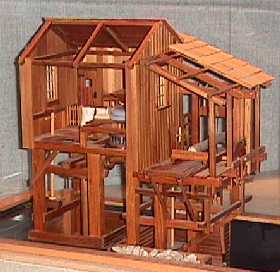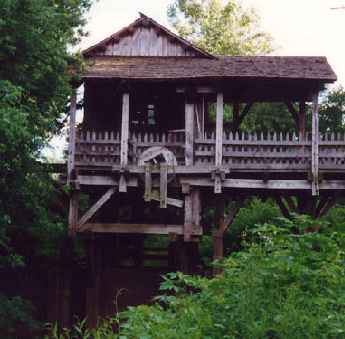Sadly not everything is recorded in history. There is no pay stub showing that Abraham Lincoln worked at New Salem's sawmill. Funny though, he did work in a sawmill -- well the grist mill side of Denton Offutt's mill. In 1831, Offutt gave Lincoln his first job in New Salem. At the mill, Lincoln's work ethic and his dealing with farmer's wheat caught the eye of visitors and townspeople alike.
 |
| Working model sawmill housed at New Salem |
Sadly, no one talked about Abe working in the sawmill. What's important for us though is Lincoln found himself working at the heart of "every" frontier community. New Salem's founders owned the grist & sawmill, and it served as the economic magnet for New Salem. While not necessarily the first business in a town, the appearance of a mill in a town drove commerce. It brought surrounding farmers to town, and to capitalize on the farmer's waiting for their lumber of milled crops, businesses popped up to take their money. Surveyors and town planners used the presence of a mill to drive sales and prices.
In July 1831, Abe found himself working at this center. The truth is that while some saw him work the mill, Lincoln mainly worked Offutt's store. Abe's boyhood life illustrated why it was so important for a town to have a dual mill in the heart of town operated by water or animals. As a boy, he went with his father over seven miles to a hand-grind mill. Here he fell in love with the machinery of the mills, and supposedly could watch the mills for hours (Burlingame).
 |
| Reconstruction of the mill |
Later in 1833, Lincoln returned to a sawmill & gristmill to make money. During the same time, Lincoln "started" splitting rails for money. His days as a railsplitter adds a whole new connection to the lumber industry.
As with everything, the question is how much about Lincoln was true or part of his frontier, self-made image created by him, his people, and myth makers. My tool to weed through the myth of the man is to take cross reference his early life with his law cases. I've come to notice the true imprints of his early life manifested themselves in the cases he chose as a lawyer. Thus, when Burlingame, the author of Lincoln: A Life, references Lincoln's time working in the sawmill as his inspiration behind taking Parker vs Hoyt, one sees that tall tales do have some truth. Even if it was the waterwheel that left an imprint on Lincoln.


No comments:
Post a Comment